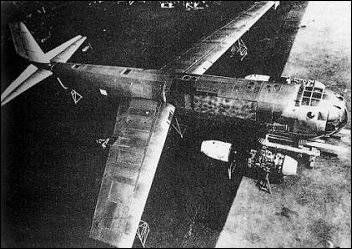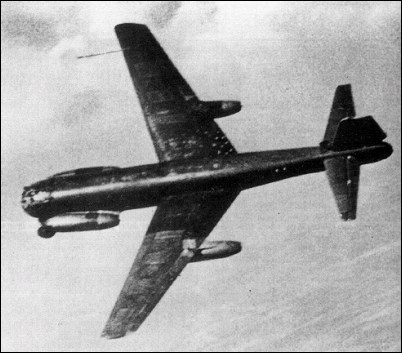 |
Junkers Ju 2871944 |  |
| EXPERIMENTAL AIRCRAFT | Virtual Aircraft Museum / Germany / Junkers |
 |
The Ju 287 was an unconventional jet bomber prototype with forward swept wings. Two of the engines were fixed to the sides of the front fuselage, two under the wings. The Ju 287 used the fuselage of the , the tail of the Ju 388, the main wheels of the Ju 352 and the nose wheel of a Consolidated B-24 Liberator. Only one was built. Development continued postwar in the USSR.

Vahe David Demirjian, e-mail, 05.08.2020  deaftom deaftomThe engine arrangement depicted in three-view drawing was the original engine arrangement for the production Ju 287 as well as Ju 287 V2. However, aerodynamic issues popped up with the fuselage-mounted engines during wind tunnel tests at Dessau, so the engine arrangement was changed to two clover leaf-shaped underwing pods of three engines. Also, the gun turret is left out in this drawing, because the production Ju 287 had a tail gun turret, which could be a controlled by a periscopic sight. Vahe David Demirjian, e-mail, 05.08.2020  Karl KarlOnly the first Junkers Ju 287 prototype was completed and flown. The second Ju 287 prototype (RS+RB) was nearing completion when the Ju 287 program was cancelled in September 1944. The Ju 287 V3 (which mirrored the design of the planned production Ju 287) was 80-90 percent complete by the time that WW2 in Europe ended. Lommel (2004) states that the fourth Ju 287 prototype (planned prototype for the production Ju 287) was 60% complete, and it also noteworthy that two more Ju 287 prototypes (V5 and V6) were armed, unlike V3 and V4. Vahe David Demirjian, e-mail, 05.08.2020  Matt Sipple Matt SippleThe Germans hid the first and second Ju 287 prototypes in the forest at Brandis, camouflaging them with branches, and they eventually blew up both planes with explosives to prevent them from falling into Allied hands. However, the Americans entered Brandis in April 1945, and the remnants of the second Ju 287 prototype, including the wings, would be used in the construction of the EF 131 bomber.
|  COMPANY PROFILE | ||||||||||||||||||||||||||||||||||||||||||||||||||||||||||
 |

|



The Ju 287 V2 and V3 were never flown in the USSR after WW2. The Ju 287 version flown in the USSR that you're talking about was the EF 131. The second prototype Ju 287 had the same airframe as the V1, but the elevators were lowered by 12 inches, the main undercarriage struts with an inward cant, and the nose undercarriage pants painted in a bright color. The Ju 287 V2 indeed had six engines (four BMW 003s, two Jumo 004s), like Ju 287 V3 and EF 131; the engine configuration originally was to comprise four underwing BMW 003s and two fuselage-mounted Jumo 004s, but was later changed to two underwing pods of three engines, the Jumos slung under the BMW 003s. The Ju 287 V3 and production Ju 287 had an airframe based on the Ju 288 and Ju 388. Three more Ju 287 prototypes were planned, of which V5 and V6 were armed.
Going back to the EF 131, this had the same airframe as the planned production Ju 287, but had a slightly longer fuselage, six Jumo 004Bs, and seven RATO boosters. First flight was on May 23, 1947, but the aircraft did not enter production and the program was canceled in June 1948.
reply